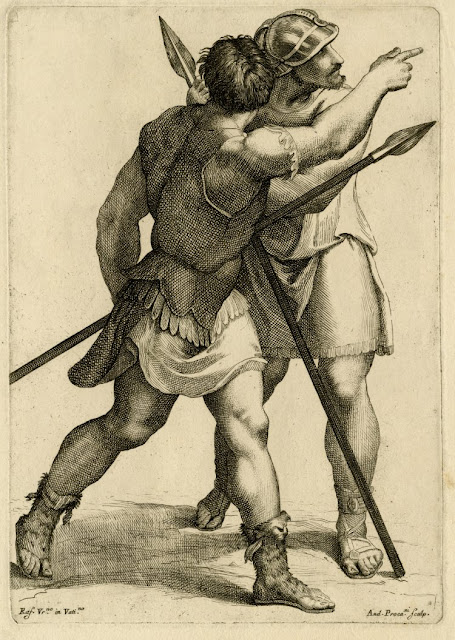 |
| Marcantonio Franceschini Angel leaning over a tablet ca. 1690-95 drawing Metropolitan Museum of Art, New York |
 |
| Andrea Procaccini after Raphael Two soldiers 17th century etching British Museum |
"There is surely a nearer apprehension of any thing that delights us in our dreams, than in our waked senses: without this I were unhappy; for my awaked judgement discontents me, ever whispering unto me, that I am from my friend; but my friendly dreams in the night requite me, and make me think I am within his arms. I thank God for my happy dreams, as I do for my good rest; for there is a satisfaction in them unto reasonable desires, and such as can be content with a fit of happiness; and surely it is not a melancholy conceit to think we are all asleep in this world, and the conceits of this life are as mere dreams to those of the next; as the phantasms of the night, to the conceits of the day. There is an equal delusion in both, and the one doth but seem to be the emblem or picture of the other: we are somewhat more than ours selves in our sleeps, and the slumber of the body seems to be but the waking of the soul. . . . In one dream I can compose a whole comedy, behold the action, apprehend the jests, and laugh my self awake at the conceits thereof. Were my memory as faithful as my reason is then fruitful, I would never study but in my dreams; and this time also would I chuse for my devotions: but our grosser memories have then so little hold of our abstracted understandings, that they forget the story, and can only relate to our awaked souls, a confused and broken tale of that that hath passed."
– from Religio Medici by Sir Thomas Browne (1643)
 |
| Bernardo Strozzi Sketches 17th century drawing Morgan Library, New York |
 |
| Anthony van Dyck Sketches after Titian 17th century drawing British Museum |
 |
| Stefano della Bella Theseus and Ariadne from the Game of Mythology 1644 etching Metropolitan Museum of Art, New York |
 |
| Anonymous copy of a Parmigianino drawing in the Louvre Apollo 17th century drawing British Museum |
 |
| Annibale Carracci Sculptural Torso early 17th century drawing Royal Collection, Great Britain |
 |
| Jan de Bisschop Painter at an Easel ca. 1648-71 wash drawing Rijksmuseum, Amsterdam |
 |
| Willem Panneels after Peter Paul Rubens Drunken Silenus with Nymphs and Satyrs 1632 etching British Museum |
 |
| Jusepe de Ribera Drunken Silenus with Pan and Satyrs 1628 etching, engraving British Museum |
 |
| Giovanni Battista Falda Catafalque funeral memorial in Florence for Philip IV of Spain 1665 etching British Museum |
 |
| Gregorio de' Ferrari Design for an Overdoor ca. 1670-90 drawing Metropolitan Museum of Art, New York |
 |
| Pietro Santi Bartoli Aldobrandini Wedding (left) ca. 1693 engraving Philsdelphia Museum of Art |
 |
| Pietro Santi Bartoli Aldobrandini Wedding (right) ca. 1693 engraving Philadelphia Museum of Art |
The fresco called the Aldobrandini Wedding was one of the few Roman wall-paintings known before the excavation of Pompei and Herculaneum in the 18th century. It generated enormous amounts of conjecture and commentary throughout the 17th century. Pietro Santi Bartoli's engravings were intended to provide a minutely accurate rendering for European scholars who could not examine the original in Rome.